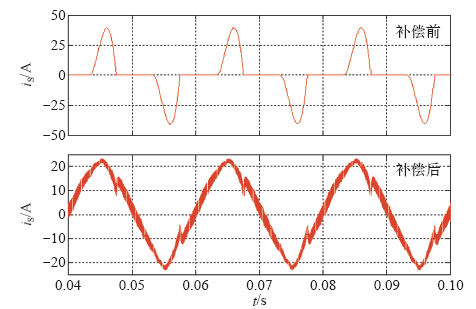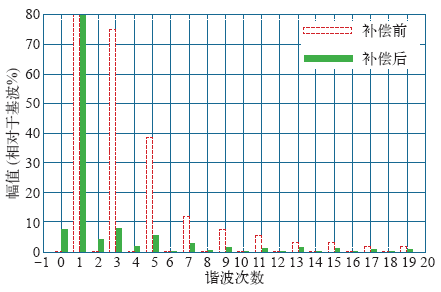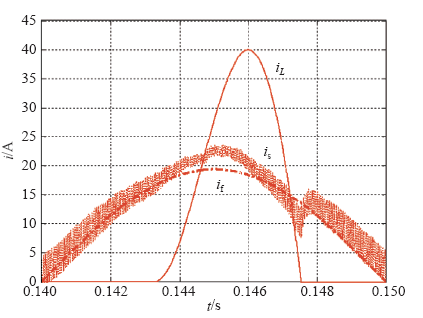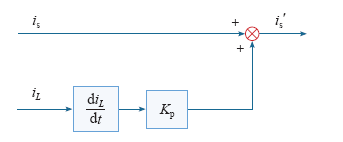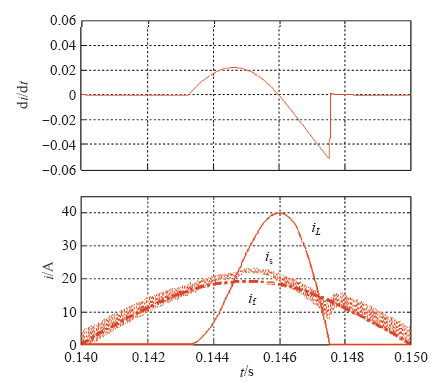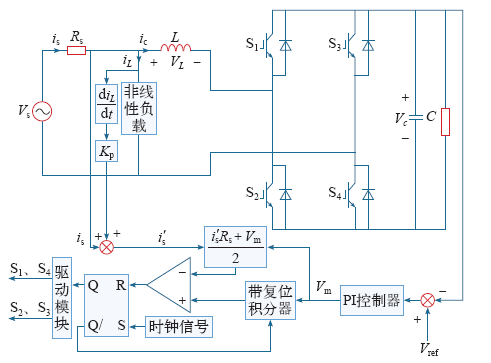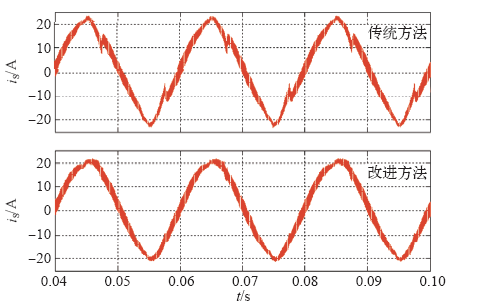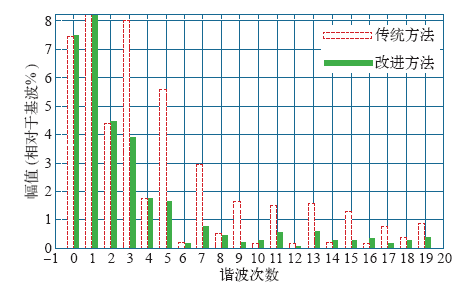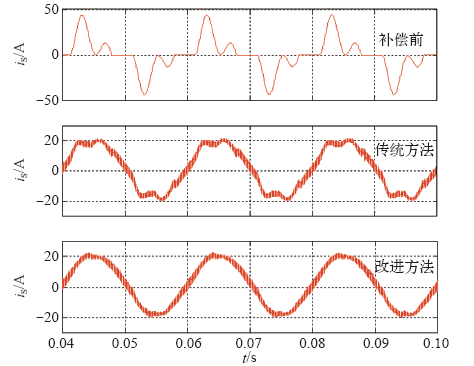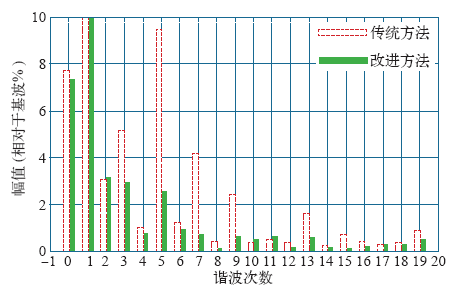1 引言
2 单周控制双极性调制APF
单相全桥并联型APF主电路如图1所示。APF与非线性负载并联,由APF产生与非线性负载电流iL所包含的谐波成分大小相同,方向相反的补偿电流ic,从而将电网电流is补偿成正弦电流。
图1
2.1 单周控制原理
为简化电路模型,假设[14]:
(1)全桥电容电压Vc高于交流电源电压Vs的峰值。
(2)全桥开关频率远远大于电网频率,因此在一个开关周期内电网电压近似是恒定值。
(3)储能电容足够大,一个开关周期内其电压为恒定值。
在双极性调制下,开关S1、S4与S2、S3的驱动信号互补,共有两种工作状态。设开关动作周期为Ts,S1、S4驱动信号占空比为D,因此S1、S4开通时间为tS1S4 = Ton = DTs。S2、S3开通时间为tS2S3 = Ts - Ton = (1 - D)Ts。
由图1可知,当S1、S4开通时,电感两端的电压VL与电网电压Vs和APF电容电压Vc的关系为

当S2、S3开通时,VL与Vs和Vc的关系为

因为开关频率远大于电网频率,由伏秒平衡原理可得,电感电压在一个周期内平均值不变

式(3)经过化简得

如APF完全补偿谐波电流,此时电网电流is即变成与Vs同相位的正弦电流。电源的负载相当于一个纯电阻Re,可得

式(5)即为APF补偿的控制目标。当使用硬件传感器进行电流is的采样时,由于硬件本身存在内阻Rs,所以令

将式(5)和式(6)代入式(4),得

由前述假设条件可将式(7),近似为

依据式(8)可得并联型APF的单周控制如图2所示。
图2
通过对直流侧电容采样的Vc与参考电压Vref比较后经PI控制器得到Vm,积分器在每个采样周期对Vm积分,积分值与(isRs + Vm)/2进行比较。当 
2.2 传统方法仿真
使用Matlab/Simulink进行仿真,设置电源电压Vs有效值为220V,频率50Hz。APF全桥电路输出串联电感L为1.75mH,并联电容C为10mF,开关频率20kHz。负载为具有串联电感与并联电容的单相不控整流负载,整流桥的负载电阻为30Ω,串联电感为2mH,并联电容取为1mF。
图3
图4
3 改进单周控制方法
由图3可知,采用APF补偿后电网电流的波形得到很大改善,但在非线性负载电流发生突变的时刻,即峰值左右时刻,补偿后的电流仍有较明显的畸变。本文主要针对传统单周控制在非线性负载电流突变时,补偿电流畸变的情况,提出了一种负载电流微分补偿方法。
3.1 传统方法补偿畸变分析
由于APF的开关频率一般在20kHz左右,传统单周控制可以满足一般的电流跟踪要求。但对于整流型负载的电容充电电流,具有很高的谐波含量。以本案为例,非线性负载的电流THD为85.25%。
在峰值充电电流的前后沿,非线性负载电流的diL/dt很大。采用传统单周控制时,补偿电流无法及时跟随负载电流的变化。从而导致当负载电流突然增大时,发生欠补偿;当负载电流急剧减少时,发生过补偿。如图5所示,其中,iL为非线性负载电流,is为APF实际补偿后的电网电流,if为APF理想补偿后的电网电流。从0.144~0.146s负载电流iL快速上升的过程中,is大于if,APF处于欠补偿状态;从0.146~0.148s负载电流iL快速下降的过程中,is开始逐渐小于if,APF处于过补偿状态。因此补偿后的电网电流发生一定畸变。
图5
3.2 负载电流微分补偿
为了改善APF的补偿效果,本文在电流反馈信号中加入一定权重的diL/dt,以提高系统对非线性负载电流快速变化的响应速度。负载电流微分补偿模块如图6所示。
图6
在电网电流反馈信号中加入一定权重的负载电流微分,将is′代替is作为电流反馈给入电流环,其中,kp为负载电流微分权重。此时式(7)可变为

如图7所示,当0.144~0.146s负载电流上升导致电网电流逐渐欠补偿时,Kp(diL/dt)>0,反馈中增加|Kp(diL/dt)|使得S1与S4开关开通时间增加,提高补偿电流,防止欠补偿,从而减小电网电流is的值。当0.146~0.148s负载电流下降导致电网电流逐渐过补偿时,Kp(diL/dt)<0,反馈中减少|Kp(diL/dt)|使得S1与S4开关开通时间减少,减少补偿电流,抑制过补偿,从而增加电网电流is的值。因此引入负载电流微分补偿模块能够在电流突变过程中改善APF的补偿效果。
图7
4 仿真验证
引入负载电流微分补偿后,可以得到改善后的单周控制如图8所示,其中,Kp(diL/dt)可通过传统微分电路实现。
图8
使用Matlab/Simulink进行仿真验证,试验条件与上文相同。
负载电流微分补偿模块Kp设置为100。其他电路参数设置与传统方法相同,两种方法补偿后is对比波形如图9所示。
图9
增加负载电流微分补偿环节后,is负载电流突变时刻的APF先欠补偿后过补偿导致的畸变得到明显改善,THD值从传统方法补偿后的14.79%下降到11.04%,如图10所示。
图10
图11
图12
改变非线性负载的输出电流后,传统方法补偿的THD值为15.33%,改进方法补偿的THD值为10.31%。可见改进方法在非线性负载电流突变严重时,能有效改善单周控制APF的补偿效果。
5 结论
本文分析了双极性调制单相全桥并联型有源电力滤波器单周控制的原理,并且针对传统方法在非线性负载电流突变时补偿后的电网电流存在畸变的情况,提出了引入负载电流微分环节来改善对电网电流的补偿。
采用Matlab/Simulink进行对比仿真,验证了增加负载电流微分环节后,在负载电流突变时能有效减少APF补偿后电网电流的畸变。该方法简单有效,增强了单周控制并联型APF的实用性。
参考文献
四桥臂有源滤波器无差拍控制策略研究
[J].
DOI:10.3390/nano9121762
URL
PMID:31835790
[本文引用: 1]

In this work, porous carbon-vanadium oxynitride (C-V2NO) nanostructures were obtained at different nitridation temperature of 700, 800 and 900 °C using a thermal decomposition process. The X-ray diffraction (XRD) pattern of all the nanomaterials showed a C-V2NO single-phase cubic structure. The C-V2NO obtained at 700 °C had a low surface area (91.6 m2 g-1), a moderate degree of graphitization, and a broader pore size distribution. The C-V2NO obtained at 800 °C displayed an interconnected network with higher surface area (121.6 m2 g-1) and a narrower pore size distribution. In contrast, at 900 °C, the C-V2NO displayed a disintegrated network and a decrease in the surface area (113 m2 g-1). All the synthesized C-V2NO yielded mesoporous oxynitride nanostructures which were evaluated in three-electrode configuration using 6 M KOH aqueous electrolyte as a function of temperature. The C-V2NO@800 °C electrode gave the highest electrochemical performance as compared to its counterparts due to its superior properties. These results indicate that the nitridation temperature not only influences the morphology, structure and surface area of the C-V2NO but also their electrochemical performance. Additionally, a symmetric device fabricated from the C-V2NO@800 °C displayed specific energy and power of 38 W h kg-1 and 764 W kg-1, respectively, at 1 A g-1 in a wide operating voltage of 1.8 V. In terms of stability, it achieved 84.7% as capacity retention up to 10,000 cycles which was confirmed through the floating/aging measurement for up to 100 h at 10 A g-1. This symmetric capacitor is promising for practical applications due to the rapid and easy preparation of the carbon-vanadium oxynitride materials.
Study on deadbeat control strategy of four-leg active power filter
[J].
DOI:10.3390/nano9121762
URL
PMID:31835790
[本文引用: 1]

In this work, porous carbon-vanadium oxynitride (C-V2NO) nanostructures were obtained at different nitridation temperature of 700, 800 and 900 °C using a thermal decomposition process. The X-ray diffraction (XRD) pattern of all the nanomaterials showed a C-V2NO single-phase cubic structure. The C-V2NO obtained at 700 °C had a low surface area (91.6 m2 g-1), a moderate degree of graphitization, and a broader pore size distribution. The C-V2NO obtained at 800 °C displayed an interconnected network with higher surface area (121.6 m2 g-1) and a narrower pore size distribution. In contrast, at 900 °C, the C-V2NO displayed a disintegrated network and a decrease in the surface area (113 m2 g-1). All the synthesized C-V2NO yielded mesoporous oxynitride nanostructures which were evaluated in three-electrode configuration using 6 M KOH aqueous electrolyte as a function of temperature. The C-V2NO@800 °C electrode gave the highest electrochemical performance as compared to its counterparts due to its superior properties. These results indicate that the nitridation temperature not only influences the morphology, structure and surface area of the C-V2NO but also their electrochemical performance. Additionally, a symmetric device fabricated from the C-V2NO@800 °C displayed specific energy and power of 38 W h kg-1 and 764 W kg-1, respectively, at 1 A g-1 in a wide operating voltage of 1.8 V. In terms of stability, it achieved 84.7% as capacity retention up to 10,000 cycles which was confirmed through the floating/aging measurement for up to 100 h at 10 A g-1. This symmetric capacitor is promising for practical applications due to the rapid and easy preparation of the carbon-vanadium oxynitride materials.
一种APF模糊自适应可变环宽滞环控制器
[J].DOI:10.7667/j.issn.1674-3415.2012.07.013 URL [本文引用: 1]
A novel fuzzy adaptive hysteresis band current controller for active power filter
[J].DOI:10.7667/j.issn.1674-3415.2012.07.013 URL [本文引用: 1]
三相有源电力滤波器输出波形控制方法仿真研究
[J].
DOI:10.3390/nano9121762
URL
PMID:31835790
[本文引用: 1]

In this work, porous carbon-vanadium oxynitride (C-V2NO) nanostructures were obtained at different nitridation temperature of 700, 800 and 900 °C using a thermal decomposition process. The X-ray diffraction (XRD) pattern of all the nanomaterials showed a C-V2NO single-phase cubic structure. The C-V2NO obtained at 700 °C had a low surface area (91.6 m2 g-1), a moderate degree of graphitization, and a broader pore size distribution. The C-V2NO obtained at 800 °C displayed an interconnected network with higher surface area (121.6 m2 g-1) and a narrower pore size distribution. In contrast, at 900 °C, the C-V2NO displayed a disintegrated network and a decrease in the surface area (113 m2 g-1). All the synthesized C-V2NO yielded mesoporous oxynitride nanostructures which were evaluated in three-electrode configuration using 6 M KOH aqueous electrolyte as a function of temperature. The C-V2NO@800 °C electrode gave the highest electrochemical performance as compared to its counterparts due to its superior properties. These results indicate that the nitridation temperature not only influences the morphology, structure and surface area of the C-V2NO but also their electrochemical performance. Additionally, a symmetric device fabricated from the C-V2NO@800 °C displayed specific energy and power of 38 W h kg-1 and 764 W kg-1, respectively, at 1 A g-1 in a wide operating voltage of 1.8 V. In terms of stability, it achieved 84.7% as capacity retention up to 10,000 cycles which was confirmed through the floating/aging measurement for up to 100 h at 10 A g-1. This symmetric capacitor is promising for practical applications due to the rapid and easy preparation of the carbon-vanadium oxynitride materials.
Simulation study on control method of output waveform of three-phase APF
[J].
DOI:10.3390/nano9121762
URL
PMID:31835790
[本文引用: 1]

In this work, porous carbon-vanadium oxynitride (C-V2NO) nanostructures were obtained at different nitridation temperature of 700, 800 and 900 °C using a thermal decomposition process. The X-ray diffraction (XRD) pattern of all the nanomaterials showed a C-V2NO single-phase cubic structure. The C-V2NO obtained at 700 °C had a low surface area (91.6 m2 g-1), a moderate degree of graphitization, and a broader pore size distribution. The C-V2NO obtained at 800 °C displayed an interconnected network with higher surface area (121.6 m2 g-1) and a narrower pore size distribution. In contrast, at 900 °C, the C-V2NO displayed a disintegrated network and a decrease in the surface area (113 m2 g-1). All the synthesized C-V2NO yielded mesoporous oxynitride nanostructures which were evaluated in three-electrode configuration using 6 M KOH aqueous electrolyte as a function of temperature. The C-V2NO@800 °C electrode gave the highest electrochemical performance as compared to its counterparts due to its superior properties. These results indicate that the nitridation temperature not only influences the morphology, structure and surface area of the C-V2NO but also their electrochemical performance. Additionally, a symmetric device fabricated from the C-V2NO@800 °C displayed specific energy and power of 38 W h kg-1 and 764 W kg-1, respectively, at 1 A g-1 in a wide operating voltage of 1.8 V. In terms of stability, it achieved 84.7% as capacity retention up to 10,000 cycles which was confirmed through the floating/aging measurement for up to 100 h at 10 A g-1. This symmetric capacitor is promising for practical applications due to the rapid and easy preparation of the carbon-vanadium oxynitride materials.
An advanced current control strategy for three-phase shunt active power filters
[J].
DOI:10.1109/TIE.2012.2229677
URL
[本文引用: 1]

This paper proposes an advanced control strategy to enhance performance of shunt active power filter (APF). The proposed control scheme requires only two current sensors at the supply side and does not need a harmonic detector. In order to make the supply currents sinusoidal, an effective harmonic compensation method is developed with the aid of a conventional proportional-integral (PI) and vector PI controllers. The absence of the harmonic detector not only simplifies the control scheme but also significantly improves the accuracy of the APF, since the control performance is no longer affected by the performance of the harmonic tracking process. Furthermore, the total cost to implement the proposed APF becomes lower, owing to the minimized current sensors and the use of a four-switch three-phase inverter. Despite the simplified hardware, the performance of the APF is improved significantly compared to the traditional control scheme, thanks to the effectiveness of the proposed compensation scheme. The proposed control scheme is theoretically analyzed, and a 1.5-kVA APF is built in the laboratory to validate the feasibility of the proposed control strategy.
An OCC-APF control strategy for unbalanced grid conditions
[C].
四桥臂APF电流跟踪法研究
[J].
Research on current tracking control method for four-leg APF
[J].
单周期控制策略在统一电能质量调节器中的应用研究
[J].DOI:10.7667/j.issn.1674-3415.2009.22.007 URL [本文引用: 1]
Applied research on one-cycle control method of unified power quality conditioner
[J].DOI:10.7667/j.issn.1674-3415.2009.22.007 URL [本文引用: 1]
基于单周控制有源电力滤波器的微网谐波抑制方法
[J].
Micro-grid harmonic suppression method based on one cycle controlled active power filter
[J].
A three-phase four-wire three-level active power filter based on one-cycle control
[C].
矢量模式单周期控制三相有源功率因数校正技术的研究
[J].
Study of the three-phase APFC circuit based on vector mode one-cycle control
[J].
基于谐波误差补偿的单周控制有源电力滤波器
[J].
DOI:10.3390/nano9121762
URL
PMID:31835790
[本文引用: 1]

In this work, porous carbon-vanadium oxynitride (C-V2NO) nanostructures were obtained at different nitridation temperature of 700, 800 and 900 °C using a thermal decomposition process. The X-ray diffraction (XRD) pattern of all the nanomaterials showed a C-V2NO single-phase cubic structure. The C-V2NO obtained at 700 °C had a low surface area (91.6 m2 g-1), a moderate degree of graphitization, and a broader pore size distribution. The C-V2NO obtained at 800 °C displayed an interconnected network with higher surface area (121.6 m2 g-1) and a narrower pore size distribution. In contrast, at 900 °C, the C-V2NO displayed a disintegrated network and a decrease in the surface area (113 m2 g-1). All the synthesized C-V2NO yielded mesoporous oxynitride nanostructures which were evaluated in three-electrode configuration using 6 M KOH aqueous electrolyte as a function of temperature. The C-V2NO@800 °C electrode gave the highest electrochemical performance as compared to its counterparts due to its superior properties. These results indicate that the nitridation temperature not only influences the morphology, structure and surface area of the C-V2NO but also their electrochemical performance. Additionally, a symmetric device fabricated from the C-V2NO@800 °C displayed specific energy and power of 38 W h kg-1 and 764 W kg-1, respectively, at 1 A g-1 in a wide operating voltage of 1.8 V. In terms of stability, it achieved 84.7% as capacity retention up to 10,000 cycles which was confirmed through the floating/aging measurement for up to 100 h at 10 A g-1. This symmetric capacitor is promising for practical applications due to the rapid and easy preparation of the carbon-vanadium oxynitride materials.
One cycle control active power filter based on harmonic error compensation
[J].
DOI:10.3390/nano9121762
URL
PMID:31835790
[本文引用: 1]

In this work, porous carbon-vanadium oxynitride (C-V2NO) nanostructures were obtained at different nitridation temperature of 700, 800 and 900 °C using a thermal decomposition process. The X-ray diffraction (XRD) pattern of all the nanomaterials showed a C-V2NO single-phase cubic structure. The C-V2NO obtained at 700 °C had a low surface area (91.6 m2 g-1), a moderate degree of graphitization, and a broader pore size distribution. The C-V2NO obtained at 800 °C displayed an interconnected network with higher surface area (121.6 m2 g-1) and a narrower pore size distribution. In contrast, at 900 °C, the C-V2NO displayed a disintegrated network and a decrease in the surface area (113 m2 g-1). All the synthesized C-V2NO yielded mesoporous oxynitride nanostructures which were evaluated in three-electrode configuration using 6 M KOH aqueous electrolyte as a function of temperature. The C-V2NO@800 °C electrode gave the highest electrochemical performance as compared to its counterparts due to its superior properties. These results indicate that the nitridation temperature not only influences the morphology, structure and surface area of the C-V2NO but also their electrochemical performance. Additionally, a symmetric device fabricated from the C-V2NO@800 °C displayed specific energy and power of 38 W h kg-1 and 764 W kg-1, respectively, at 1 A g-1 in a wide operating voltage of 1.8 V. In terms of stability, it achieved 84.7% as capacity retention up to 10,000 cycles which was confirmed through the floating/aging measurement for up to 100 h at 10 A g-1. This symmetric capacitor is promising for practical applications due to the rapid and easy preparation of the carbon-vanadium oxynitride materials.
基于矢量运算的 OCC APF 在不对称系统下的研究
[J].
DOI:10.1038/s41598-019-55333-1
URL
PMID:31836756
[本文引用: 2]

This work reports a method to select the optimal working frequency in transversal bulk resonator acoustophoretic devices by electrical impedance measurements. The impedance spectra of acoustophoretic devices are rich in spurious resonance peaks originating from different resonance modes in the system not directly related to the channel resonance, why direct measurement of the piezoelectric transducer impedance spectra is not a viable strategy. This work presents, for the first time, that the resonance modes of microchip integrated acoustophoresis channels can be identified by sequentially measuring the impedance spectra of the acoustophoretic device when the channel is filled with two different fluids and subsequently calculate the Normalized Differential Spectrum (NDS). Seven transversal bulk resonator acoustophoretic devices of different materials and designs were tested with successful results. The developed method enables a rapid, reproducible and precise determination of the optimal working frequency.
Study on one-cycle control active power filter based on vector computing in unbalanced systems
[J].
DOI:10.1038/s41598-019-55333-1
URL
PMID:31836756
[本文引用: 2]

This work reports a method to select the optimal working frequency in transversal bulk resonator acoustophoretic devices by electrical impedance measurements. The impedance spectra of acoustophoretic devices are rich in spurious resonance peaks originating from different resonance modes in the system not directly related to the channel resonance, why direct measurement of the piezoelectric transducer impedance spectra is not a viable strategy. This work presents, for the first time, that the resonance modes of microchip integrated acoustophoresis channels can be identified by sequentially measuring the impedance spectra of the acoustophoretic device when the channel is filled with two different fluids and subsequently calculate the Normalized Differential Spectrum (NDS). Seven transversal bulk resonator acoustophoretic devices of different materials and designs were tested with successful results. The developed method enables a rapid, reproducible and precise determination of the optimal working frequency.





